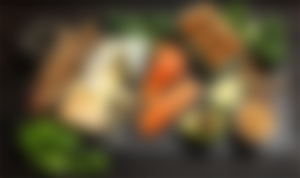You have finally made up your mind! To go on a diet? Magnificent! Now you only need three things: determination, knowing some basic secrets and learning how to prepare many recipes that are both rich and low in calories. The first, of course, depends on you, but in the last two points you will find some tips that can help you!
Some tips to follow
Start your diet as soon as possible. Remember that the sooner you start it, the sooner you will reach your desired weight.
But beware! Unless you want to lose only a few kilos, it is preferable that you consult your doctor before going on a diet. Above all, never eat a drastic diet (less than 1,200 calories a day) without medical supervision.
If a member of your family or a friend also wants to lose weight, better! Having an "ally" to count calories, to exchange recipes and to see the progress that is made helps a lot to follow the diet.
Get used to two things. First: always serve small portions of food. Second: get up from the table before you feel a feeling of fullness "in the stomach.
Always have fruits and low-calorie sodas, instant chicken or beef broth, vegetable juices, skim milk and vegetables of various kinds on hand. If you feel hungry between meals, turn to them!

Do you know what a serving is?
Perhaps, when it comes to serving, you have wondered what exactly a portion is. Although serving sizes can and do vary from one individual to another, here is a list of moderate portions of some foods (which are precisely what you should serve on a diet).
Meat, fish, poultry, eggs:
112 g (approximately 4 ounces) of raw boneless meat.
1 cooked hamburger about 9 cm (3.1 /3 inches) in size.
2 4 x 2.1 / 4-inch (10 x6 cm) slices of cooked meat or fish.
1 thigh or half of the breast of a small chicken.
For eggs, estimate one for every 28 g (about 1 ounce) of meat, poultry, or fish.
Fruits and legumes:
1 medium fruit, such as apple.
2 small fruits, such as apricots (apricots) or plums.
1/4 of cantaloupe melon.
10 or 12 cherries or grapes.
1 cup of strawberries (strawberries) or blackberries
1/2 cup of unsweetened fruit juice (the juice can be the same fresh, canned or frozen).
1/2 cup of cooked legumes
1 cup of raw leafy vegetables.
Cereals and bread:
1 slice of bread or 1 muffin.
1 cup of unsweetened instant cereal (better one fortified with iron).
1/2 cup of cooked cereal.
1/2 cup of rice, cornmeal, macaroni, noodles or spaghetti (all measured after cooking).
Milk:
1 cup of milk
Additional features:
1 teaspoon of butter, margarine or oil of any kind.
1 teaspoon salad dressing.
6 walnuts, almonds or hazelnuts.
35 calories from any other food.
How are the calories distributed?
Eating basic foods is important for good health in all circumstances, but especially when following a low-calorie diet. Do you know how many servings you should take a day of certain foods? Here are some that you cannot miss on a 1200 calorie diet and a 1500 calorie diet. In the table you can see the portions you need from the four main food groups, from the extra category, which can also be important.

Learn to choose foods
Do you know which foods to choose and which to avoid while on your diet? Please note the following indications.
Meat, poultry, fish, eggs:
Choose: lean meat, from which you must also eliminate any remaining fat; poultry and fish without the skin; boiled, baked or grilled foods. Avoid: fatty meats; sausages and cold cuts; fried foods in general.
Fruits:
Choose: fresh fruits and juices (they can also be frozen or canned unsweetened); fruits rich in vitamin C (such as oranges, grapefruit or grapefruit, strawberries or strawberries, cantaloupe melon, etc.). Avoid: fruits canned in syrup; the fruit fritters.
Vegetables:
Choose: in general, all legumes lend themselves to a diet, whether fresh, canned or frozen, as long as they are seasoned with a little oil and vinegar or lemon juice. Try, however, to eat less of the most fattening, such as beans, corn, peas, potatoes, and squash. Avoid: legumes in sauces and those prepared fried.
Milk and derived products:
Choose: skim milk enriched with vitamins; skim milk cottage cheese; low-fat cheeses. Avoid: whole milk; cream or cream; high-fat cheeses.
Additional features:
Choose: low calorie gelatin; creams and custards made with skim milk; egg whites; powdered chocolate; fluffy cakes (made without butter and only with the egg white); Butterscotch or popcorn without butter or other topping Low calorie jams and jellies. You can eat butter or margarine, mayonnaise, but in small quantities. Avoid: whipped cream; non-powdered chocolate; candy; buttered or high-calorie cakes; cakes and cookies; fried treats; regular jams and jellies; creamy sauces.
Thank you for visiting my publication, I hope these tips will be of great help if you want to start a diet or simply want to eat in a healthy and balanced way.
Main Image: https://u-matter.org.uk/lifestyle-categories/healthy-diet


I don't know how we'll be able here in Serbia to maintain our weight when there is a lot of holidays coming up. Anyway, we need to balance our diet and to do cleansing of the body in order to get rid of damaging food remains.